MATH 6820 Week 10: Loess
Loess
First, simulates some (x, y) data where the true signal follows one of the curves sin(x)+cos(x), sin(x)-cos(x), sin(x)*cos(x), .28-.88*x-0.03*x^2+.14*x^3.
Then we get a list, where d$x is the x values and d$y contains the y values.
> head(cbind(d$x,d$y))
[,1] [,2]
[1,] -3.141593 -0.7723653
[2,] -3.110019 -1.0347078
[3,] -3.078445 -1.3321508
[4,] -3.046871 -1.9027887
[5,] -3.015297 -1.4537965
[6,] -2.983724 -1.9512365
Using the simulated data …
1. Construct a scatterplot of your data and overlay a lowess smooth (using the default value of f in the lowess function).
Loess produces smoothed values at any desired collection of values along the x scale and summarizes how y depends on x. From the above graph, we can see that there is nonlinear relationship between x and y. An increase in Y as x increases until x is close to 1,saying a positive relationship between x and y and the effect is nearly linear and the slope is close to 1. From 1 and above, the an decrease in Y as x increases until x is close to 3,saying a negative relationship between x and y and the effect is nearly linear and the slope is close to -1.(The whole graph is definitely nonlinear, just for better explanation, I divided the graph into two parts, each part seems linear relationship between x and y. )
2. Construct a plot of residuals and comment if the lowess curve has effectively found the signal.
There is a fluctuant pattern in the residual graph, the problem is that the loess smoothing in the top panel has missed part of the pattern because is too large, and this missed part has gone into the residuals. In this case, we should reduce value, (For example, drop from default alpha to alpha=0.25 ), Although the amount of smoothing for the curve may be not great, the loess curve on the residual will be reasonable close to a horizontal line, which suggests the loess curve with is not distorting the underlying pattern in the data.
Then I combine two graphs in one for better visual effect:
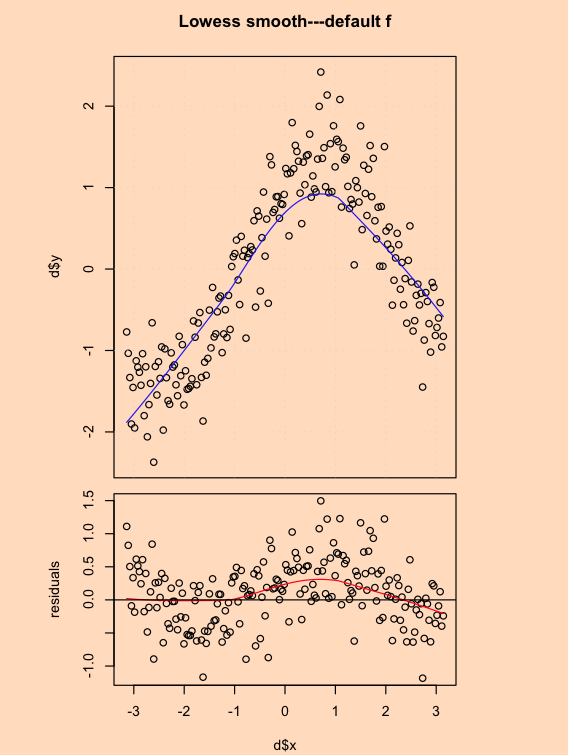 By combining two graph together, we can see clearly both relationships of y and x and residuals and x, with the same horizontal scale.
By combining two graph together, we can see clearly both relationships of y and x and residuals and x, with the same horizontal scale.
3. Assuming that a better smooth can be found, construct a scatterplot using a better choice of f. By the use of a residual plot, demonstrate that your choice of f is better than the default choice in 1.
Since the default f yields certain pattern in residuals, which means alphais too big, I reduce the alpha value from default to 0.25 eventually. First I tried alpha=0.5, however the loess curve on the residual graph still shows a fluctuated pattern, then I continuous drop alpha value from 0.5 to 0.4, 0.3, 0.25, until the loess curve on the residual graph is nearly a horizontal line since the residuals should be variation in y not explainable by x. Meanwhile, to keep alpha from being too small is to increase it to point where the residual graph just begins to show a pattern, and then use a slightly smaller value of . In this case, we can either avoid the loess curve on the residual has a pattern, or keep from being too small. As saying above, I end up with using alpha=0.25, which make the loess curve on the residual graph is nearly a horizontal line.
To demonstrate the whole procesure, I first upload a graph with alpha=0.5, which makes the residuals vs. X still has a certain pattern. 
From this graph, we can see that f=0.5 is not the best choice, since the fluctuated pattern still exist. Then I continuous reduce f value until the loess curve on the residual graph is nearly a horizontal line, with f=0.25.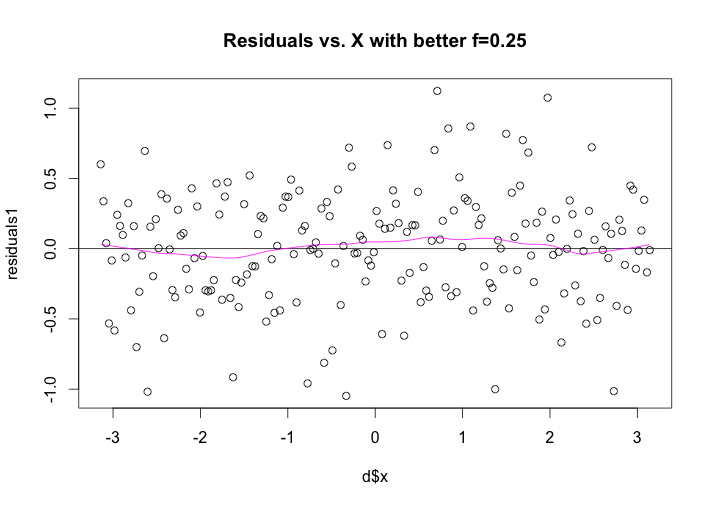
As we see in the above graph, comparing to the default value alpha=2/3, which has obvious fluctuate pattern in residual, the loess curve on the residual graph is nearly a horizontal line and the residual graph has no certain pattern, with f=0.25, which means the residuals is variation in y not explainable by x.
Also there is a new scatterplot of x and y, using a better choice of f.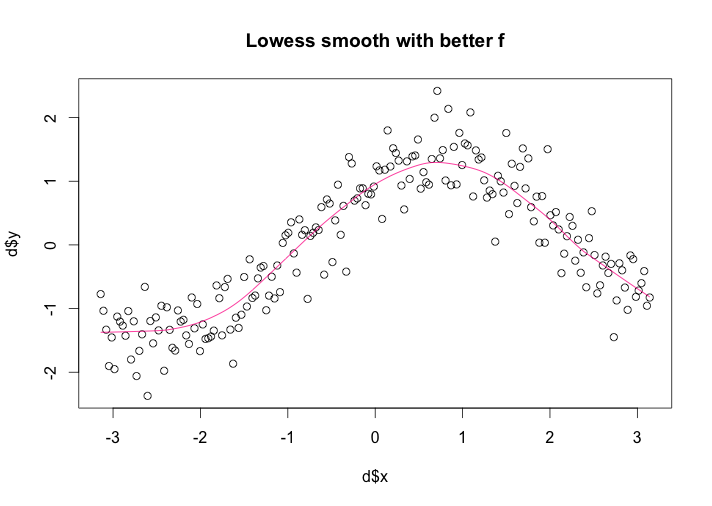
From the above graph, we can see that there is nonlinear relationship between x and y. An increase in Y as x increases until x is close to 1, the response is in fact constant until x=-2 and then the response increase as x increases until x=1. From 1 and above, the an decrease in Y as x increases until x is close to 3,saying a negative relationship between x and y. Comparing the first graph using default f, this lowess smooth explain the data better, telling us more detail information from the graph.
Finally, for better visual effect, I combine the scatterplot with lowess smooth and a plot of residual with lowess smooth in one graph. From the following graph, we can see that with the residual graph has no certain pattern, the scatterplot with lowess smooth could explain the original data better.Comparing to the default value(alpha=2/3), alpha=0.25 yield better lowess smooth. Also,by combining two graph together, we can see clearly both relationships of y and x and residuals and x, with the same horizontal scale.
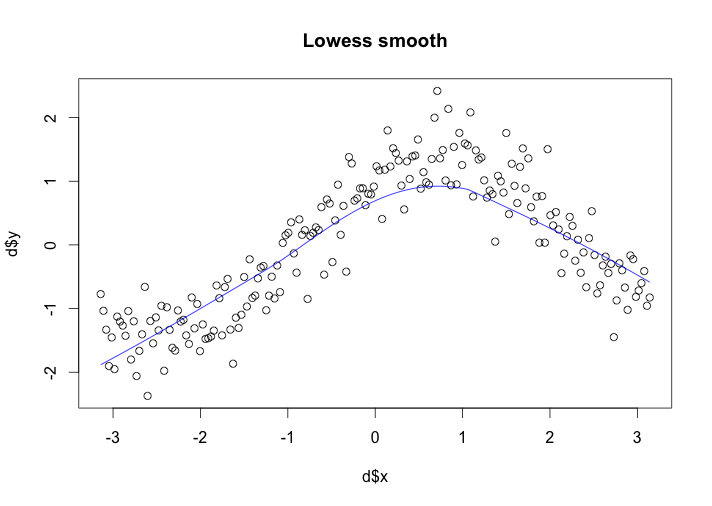
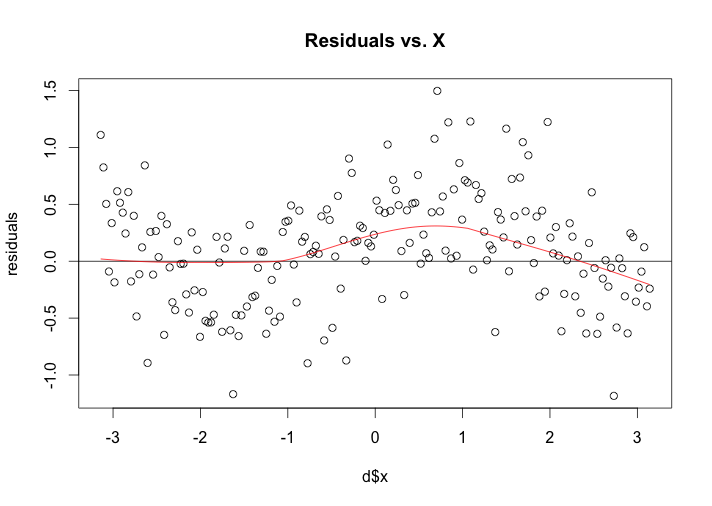

April 20th, 2013 at 8:01 am
It is not my first time to visit this website, i am visiting this web page dailly and take nice data from here daily.
April 21st, 2013 at 11:00 am
This design is incredible! You obviously know how to keep a reader amused.
Between your wit and your videos, I was almost moved to start my own blog (well,
almost…HaHa!) Wonderful job. I really loved what you had to say, and more than that, how you presented it.
Too cool!
April 21st, 2013 at 10:45 pm
Thank you for supporting!